Nose & Ear Hospital
Specialist
The Central London Throat and Ear Hospital was founded as a dispensary in Manchester Street (later renamed Argyle Street) by Drs. Lennox Browne (1841-1902) and Llewellyn Thomas in 1874. Both had trained under Dr. Morell Mackenzie at the Hospital for Diseases of the Throat in Golden Square. Dr. Lennox Browne was a leading Freemason and this provided him with a ready network of contacts for financial support within the Masonic movement (which was very strong in the medical world).
In 1875 one of the leading singers of the time, Mme Adelina Patti, Marquise de Caux, laid the foundation stone for a purpose-built hospital on a narrow site in Grays Inn Road, between St Jude's Church and a public house, The Pindar of Wakefield (now The Water Rats) and just across from the original Hospital building. The new Hospital was also near the Royal Free Hospital, established in 1823, with which it would have strong links later. At this time the area around Grays Inn Road was known as 'Shadyville', with "mysterious alleys and slums".
The Central London Throat Nose & Ear Hospital (CLTNEH) opened in 1877, with 15 beds. (The word 'Nose' was added to its title at this time, although this had been included in the original description at its foundation). The first ward of the Hospital was named after Mme Patti. Most of the leading laryngologists had a clientele of actors and public speakers, as well as singers. The Hospital was enlarged in 1879, when it had 16 beds, and again in 1892, to 17 beds.
In 1894 the Hospital closed for three months
while further building work began to provide a new Out-Patients
Department, a day room
By 1902 the Hospital was attracting many patients, some 76% coming from outside London. The location of the Hospital made it easily accessible from the railway termini of Euston, St Pancras and King's Cross. (The importance of these railway termini to the hospital movement meant that by the 1890s there were 8 general hospitals and 22 specialist hospitals within one mile of the Middlesex Hospital).
In 1902 additional land for expansion became available following the gutting of the stables in Wicklow Street. Nos. 57-67 Wicklow Street were purchased in 1903 for eventual use as a Nurses' Home.By the turn of the century central London had five ENT hospitals - the Hospital for Diseases of the Throat, the CLTNEH, the Royal Ear Hospital, the London Throat Hospital and the Metropolitan Ear Nose & Throat Hospital. In 1904 the King's Fund proposed that these should merge and, in 1905, withheld funds to force the hospitals to make a decision to amalgamate. The CLTNEH finally agreed to merge with the London Throat Hospital, only to find that it was too late, as the latter had already agreed to merge with the Hospital for Diseases of the Throat.
In 1906 Princess Louise, Duchess of Argyll, opened a new wing of the rebuilt CLTNEH, which contained a children's ward and departments for minor operations and for clinical pathology. The Princess became the Hospital's president in 1909.
By 1910 one third of in-patients and one fifth of out-patients were from outside London.
At the beginning of WW1 in 1914 eight beds were set aside for use by the War Office. The Hospital was among the 22 hospitals which agreed to treat patients with venereal disease, the prevalence of which greatly concerned the government at this time. Patients presented in ENT clinics with sores around the mouth due to syphilis, which was treated with Salvarsan.
In 1916 a new 20-bed annex was opened for soldiers deafened by explosions or shellshock. Belgian and Serbian refugees were admitted too. By 1917 the Hospital had become a section of the Second London General Hospital; some 25 beds were reserved for military cases with throat, nose or ear problems.
By the end of the war, the military beds were being used again for civilian patients. By this time the Hospital had 43 beds, but the running costs had almost doubled from £4000 to £7000 a year (but this was still a lower ratio than other hospitals). A shortage of nurses had affected expansion of the Hospital's work, so a Nurses' Home was established in Coram Street to encourage recruitment.
In 1928 work began on the building of the Princess Louise Wing. The Princess laid the foundation stone and the £60,000 Wing opened in 1929, giving the Hospital a bed total of 76. The ground floor contained an Out-Patients Department with a commodious waiting area, an operating theatre, dispensary, pathology laboratory and a students' room. The first and second floors contained a minor operations theatre and a kitchen, but the third and fourth floors were left in their shell until sufficient funds could be raised to furnish them. The expansion enabled children to be admitted overnight following removal of adenoids and tonsils instead of being discharged straight home, but the deficiency in finances meant this arrangement did not last long.
Thirty years after purchase, plans were made to convert the Wicklow Street houses close to the Hospital into a Nurses' Home, and £1000 was received anonymously following this decision, with the promise of another £2000 on condition that work started immediately.
In 1933 the Hospital opened a convalescent home - the Dame Gertrude Young Memorial Convalescent Home - in Ealing.
In 1935 the Hospital acquired the adjacent St Jude's Church which had recently closed, for sale at £7900 (the Hospital had used its hall for the past 20 years). In the same year a new Nurses' Home opened in Swinton Street. By this time the Hospital had 84 beds.A decision was taken to amalgamate with the Hospital for Diseases of the Throat in Golden Square, and a joint Committee of Management was formed, but the merger was delayed by the outbreak of WW2 (the new Royal National Throat Nose & Ear Hospital (RNTNEH) finally coming into being on 1st January 1942).
During WW2 the building received damage when the Kings Cross area was bombed. The windows were blown out and the roof holed in 1941 and 1943, but the Hospital continued treating residents, servicemen and Civil Defence workers injured by bomb blast and explosions. In October 1941 the staff and patients from the West End Hospital for Nervous Diseases were housed temporarily in the children's ward when their building was partially destroyed. They returned to their own premises in May 1942. The Hospital again suffered collateral damage when a flying bomb exploded by the Eastman Dental Hospital.
After the war the Hospital took over the Albion Printworks and paper store in Swinton Street as well as St Jude's School (bought for £4750).
In 1946 the academic Institute of Laryngology & Otology was established at the Grays Inn Road site.
In 1950 joint radiotherapy clinics were established with the Royal Marsden Hospital for the treatment of throat cancers. Cases of tuberculosis and syphilis were still common, despite the introduction of sulphonamides and penicillin; acute mastoid infection often had to be treated surgically. At this time the Hospital had 230 beds on all sites.
A Fenestration Department had been established before the war for the relief of deafness, and the procedure was regularly performed during the 1950s, until the introduction of stapedectomy in 1958 (this in its turn has been superseded by cochlear implants).
In 1953 a small mortuary chapel dedicated to St Blaise, patron saint of the throat, was built to commemorate the Coronation of Queen Elizabeth II. A service is held there on 3rd February (St Blaise's Day) every year.
The Nuffield Hearing and Speech Centre was completed and opened in 1963.
In 1965 the General Nursing Council no longer approved of the Hospital as a nurse-training school, so student nurses ceased to be appointed.
In 1982, after a major reorganisation of the NHS, the Hospital came under the control of the Bloomsbury District Health Authority.
In 1983 the Audiology Centre opened, built on the site of the former printworks. The building also houses the Pathology Museum, which is now boxed up due to the lack of a curator.
In 1996, with the introduction of further NHS reforms, the Hospital joined the Royal Free Hampstead NHS Trust.
Present status (March 2009)
Update: April 2012
In 2011 the Hospital transferred to the University College London Hospitals NHS Trust.
In 2012 the head and neck surgical services were transferred to University College Hospital. It is being considered that the entire Hospital should move to the main University College Hospital campus.
Update: July 2015
The Hospital is due to close in 2016, as is the Eastman Dental Hospital. Services will move to the new centre to be built on the site of the Royal Ear Hospital in Capper Street. The buildings will be sold off to pay for the project.
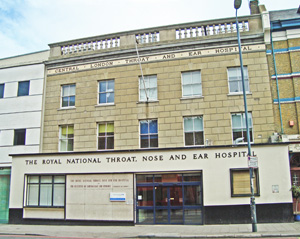
The front elevation of 330-331 Grays Inn Road, on which the name of the Hospital is written variously three times.
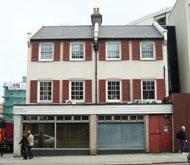
At the corner of Grays Inn Road and Britannia Street is the Institute of Laryngology and Otology, University College London (UCL).

The Britannia St elevation of the Institute of Laryngology and Otology, UCL.
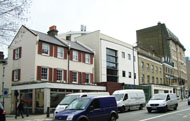
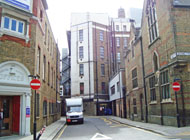
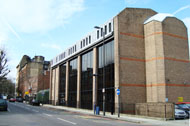
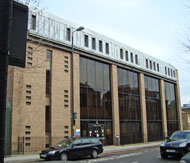
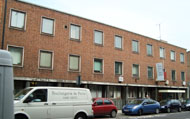
The Nuffield Hearing and Speech Centre on Swinton Street opened in 1963.
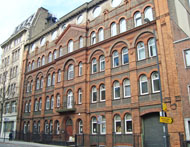
The Nurses' Home in Swinton Street, built in the 1930s at the cost of £36,000. Princess Louise had laid the foundation stone.
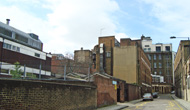
The view along Wicklow Street, looking towards the railway.
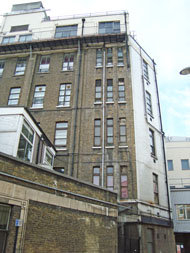
A tall ward block situated within the campus.
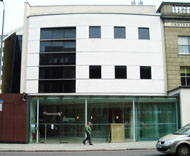
Next door, at 332 Grays Inn Road, on the site of St Jude's Church, is the UCL Ear Institute, opened in 2005.
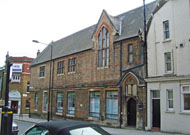
The Institute of Laryngology and Otology is also housed in the old St Jude's School building in Britannia Street.
The Audiology Centre, Swinton Street.
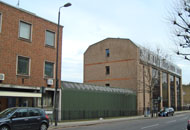
A rather ugly walkway made of corrugated iron sheeting joins the Nuffield building to the elegant Audiology Centre
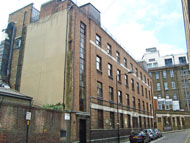
A ward block along Wicklow Street, site of the former Nurses' Home.
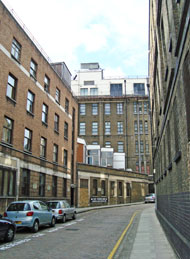
Wicklow Street, with ward blocks shown on the left and centrally.
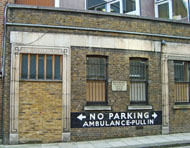
The 'New Patients Entrance' in Wicklow Street, now 'invitingly' bricked up.
Despite the Temperance movement abhorring the use of alcohol in hospitals, patients were prescribed port following tracheotomy, while those with cancers received brandy. Ulceration of the trachea required stout and removal of the larynx champagne. However, by the end of the Victorian era, most hospitals had reduced the amount of alcohol served to patients, milk being provided instead.
In 1921 the CLTNEH spent £10 on alcohol and £448 on milk, although up to 1926 raw (unpasteurized) milk was still available, that is, a source of TB.
(Author unstated 1917 List of the various hospitals treating military cases in the United Kingdom. London, H.M.S.O.
(Author unstated) 1998 The years of Lennox Browne (1874-1902). Journal of Laryngology & Otology 112 (Suppl. 22), 10-25.
Baycroft S 1990 Histopathology Collections in London. London, London Museum Services, pp. 16-17.
Black N 2006 Walking London's Medical History. London, Royal Society of Medicine Press.
Cohen B 2003 The Royal National Throat Nose and Ear Hospital in World War II: a reminiscence. Journal of Laryngology and Otology 117, 340-343.
Colledge L 1942 Amalgamation between the Golden Square Throat and Ear Hospital and the Central London Throat and Ear Hospital in Gray's Inn Road. Journal of Laryngology & Otology 57, 113-119.
Gould G 1998 A history of the Royal National Throat Nose and Ear Hospital 1874-1982. Journal of Laryngology & Otology 112, Suppl. 22.
http://discovery.nationalarchives.gov.uk
www.aim25.ac.uk
www.publiclettering.org.uk
www.ucl.ac.uk (1)
www.ucl.ac.uk (2)
www.uclh.nhs.uk
Return to home page